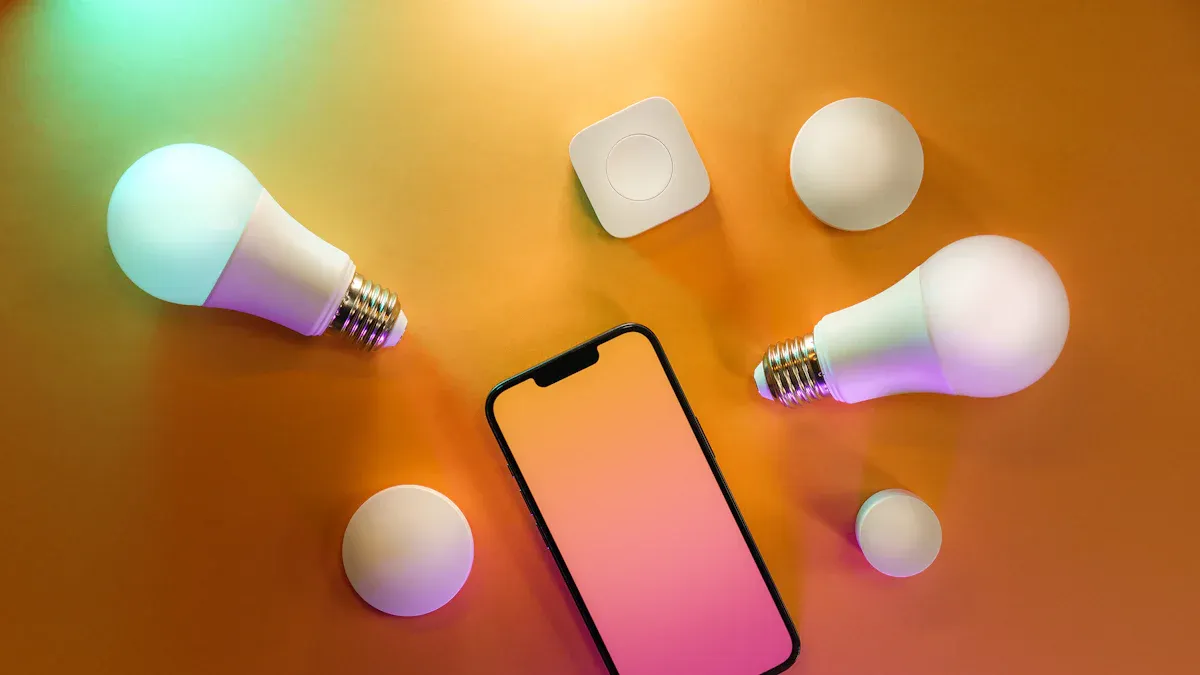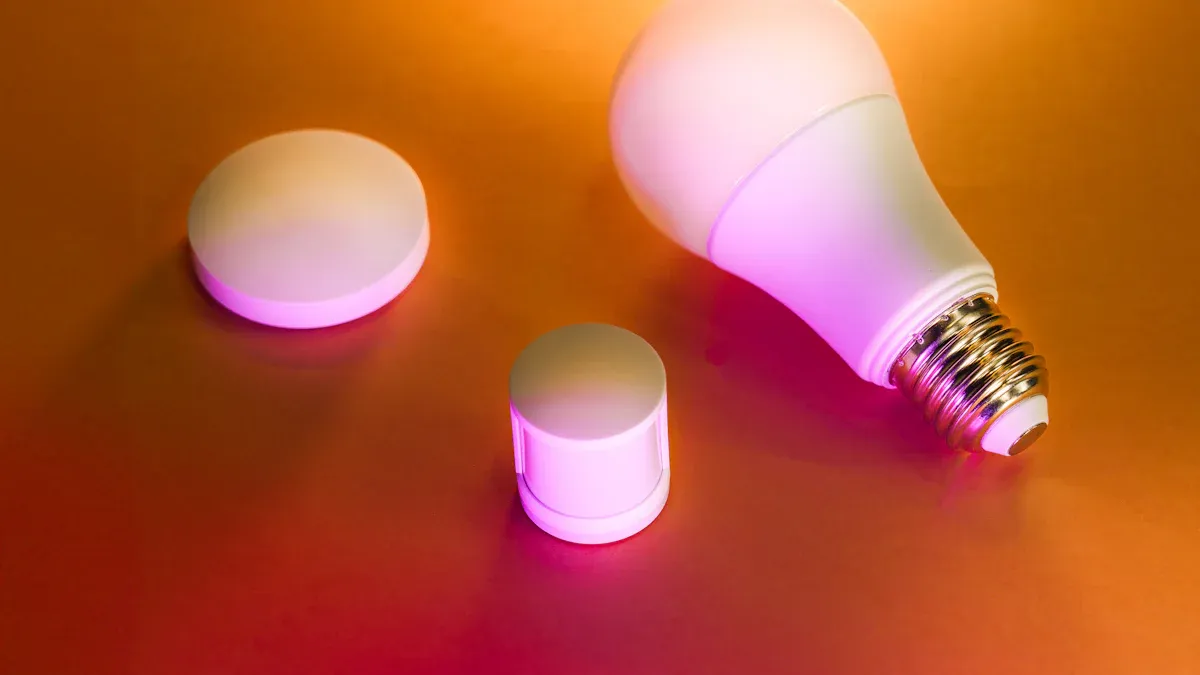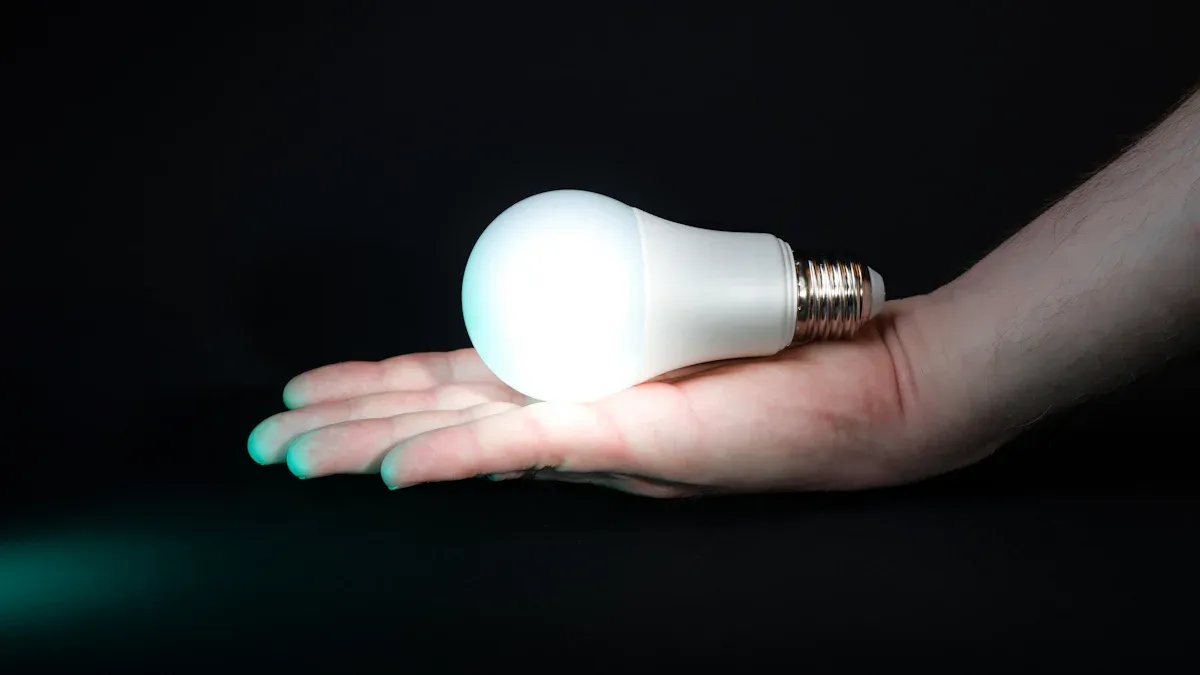LED Lights Benefits: How Switching Can Transform Your Energy Consumption and Savings

Switching to LED lights can significantly change how you use energy, showcasing the many LED lights benefits. These lights consume up to 80% less power than traditional bulbs, which helps lower your electricity bills considerably. For instance, a regular bulb uses 60 watts, while an LED light uses only 12.5 watts. Additionally, LEDs have a longer lifespan, lasting up to 50,000 hours. This results in fewer replacements and less money spent on maintenance. By choosing our product, you not only save money but also contribute positively to the environment.
💡 Fun fact! The U.S. Environmental Protection Agency states that LED lights could save enough energy by 2030 to power seven million homes for an entire year. If you want to learn more, feel free to check out the About Us section for additional information on our commitment to energy efficiency.
Key Takeaways
Using LED lights can cut energy use by 80%. This saves a lot on electricity bills.
LED lights last way longer than regular bulbs. They can shine for up to 50,000 hours. This means fewer changes and less upkeep.
LED lights save money and protect the planet. They lower greenhouse gases and stop wasting energy.
The Science Behind LED Lights Benefits
How LED Technology Works
LEDs, or Light Emitting Diodes, work in a unique way. Unlike old bulbs with filaments or gas, LEDs use semiconductors to make light. When electricity passes through the semiconductor, it excites electrons. These electrons release energy as light, a process called electroluminescence. This method wastes less energy as heat, making LEDs very efficient.
LEDs are also great because they focus light in one direction. Traditional bulbs spread light everywhere, wasting energy. LEDs shine light exactly where it’s needed. This makes them perfect for flashlights, car headlights, and decorative lights.
🔍 Did you know? LEDs can produce different colors without filters. This makes them ideal for creative lighting designs!
Why LEDs Are More Energy-Efficient Than Traditional Bulbs
LEDs are much better than traditional bulbs in saving energy. They turn most of their energy into light, not heat. This makes them up to 90% more efficient than incandescent bulbs. For example, incandescent bulbs waste 90% of energy as heat, while LEDs use almost all energy for light.
Here’s a simple comparison to show why LEDs are better:
Type of Bulb | Lumens per Watt | Lifespan (hours) | Energy Usage Comparison |
|---|---|---|---|
LED | 50-120 | 25,000 - 200,000 | Uses up to 90% less energy than incandescent |
Incandescent | 10 | ~1,200 | Generates 90% of energy as heat instead of light |
HID/CFL | 10-24 | 10,000 - 24,000 | N/A |
Switching to LEDs means using less electricity for the same brightness. This lowers your energy bills, which is one of the best LED Lights Benefits for homes and businesses.
Environmental Impact of Reduced Energy Usage
Using less energy with LEDs helps protect the planet. Lower energy use means power plants work less, reducing greenhouse gas emissions. For example, replacing one incandescent bulb with an LED can cut yearly CO2 emissions by 1,400 grams. Imagine the difference if everyone switched to LEDs!
Here’s a quick comparison of LEDs and traditional bulbs for the environment:
Metric | LED Technology | Incandescent Bulbs |
|---|---|---|
Energy Efficiency | Up to 80% more efficient | Baseline |
Lifespan | ~25,000 hours | ~1,000 hours |
Annual CO2 Emissions | 200 grams | 1,600 grams |
Potential Savings per Fixture | Up to $200 per year | N/A |
Energy Consumption Reduction | At least 75% less | N/A |
Switching to LEDs saves money and fights climate change. Choosing energy-efficient lights helps create a sustainable future.
🌱 Pro Tip: Want to help the planet even more? Replace the most-used bulbs in your home with LEDs. Start with rooms like the kitchen and living room where lights stay on the longest.
Cost-Saving Benefits of LED Lights

Switching to LED lights is more than just new technology. It’s a smart way to save money. The cost-saving benefits of LED lights go beyond their price, making them a great choice for homes and businesses.
Save Money on Electricity Bills
LED lights use much less electricity than old bulbs. For example, halogen lights cost $130.35 yearly, but LED lights cost only $31.80. That’s nearly $100 saved each year by switching. Over time, these savings grow. Using LED lights at home can save $1,009.50 in 10 years.
The savings don’t stop with homes. In 2012, 49 million LEDs saved the U.S. $675 million in energy costs. If everyone switched to LED lights, the U.S. could save $250 billion over 20 years. By using LEDs, you lower your bills and help create an energy-efficient future.
💡 Tip: Replace the most-used bulbs first, like in kitchens or living rooms. This helps you save the most money right away.
Long-Lasting Bulbs Save More Money
One amazing benefit of LED lights is how long they last. Regular bulbs work for about 1,200 hours, but LEDs last up to 50,000 hours. One LED bulb can replace 21 regular bulbs. For 25,000 hours of use, LEDs cost $26.25, while regular bulbs cost $171.
Because LEDs last so long, you don’t need to replace them often. This saves time and money. Whether it’s for your home or office, fewer replacements mean less hassle. Spending $400 on LEDs can save $219 in energy and $100 in maintenance over five years. After 1.83 years, your investment pays off, and all future savings are yours.
🛠️ Note: Use LEDs in hard-to-reach places like high ceilings. Their long life means fewer replacements and less trouble.
Less Maintenance Needed
LED lights last longer and need less care. They are strong and reliable, so you save on upkeep. Businesses can save big too. For example, Starbucks saved $4 million yearly by switching to LEDs. This shows how LEDs cut costs and improve efficiency.
With lifespans of 50,000 to 100,000 hours, LEDs rarely need replacing. This is great for large spaces where maintenance is expensive. LEDs also handle frequent on-and-off switching well, making them perfect for motion sensors or automatic lights.
🌟 Pro Tip: Use LEDs for outdoor or decorative lighting. They last long and need little care, saving you time and money.
Choosing LED lights is a smart way to save money. From lower bills to fewer replacements, the financial benefits are clear. Switch to LEDs today and enjoy the savings!
Practical Applications of LED Lights Benefits

Residential Lighting: Making Homes More Efficient
Using LED lights at home can save lots of energy. These lights use 75% less power than old incandescent bulbs. This means you get bright light while paying lower electricity bills. From 2015 to 2020, homes using LEDs grew from 4% to 47%. This shows how people are choosing energy-saving options to save money and help the planet.
LEDs work well in every room of your house. Use warm-colored LEDs in living rooms for a cozy feel. Daylight-colored LEDs are great for kitchens to see better. They last a long time, so you won’t need to replace them often. Switching to LEDs makes your home more comfortable, efficient, and eco-friendly.
🌟 Tip: Replace the most-used bulbs first, like in kitchens or living rooms, to save more money quickly.
Commercial and Industrial Uses
LED lights are changing how businesses and factories use lighting. They save up to 90% more energy than incandescent bulbs and 50% more than fluorescent ones. Here’s why they’re a great choice:
Benefit | Description |
|---|---|
Energy Savings | LEDs use less power, cutting down on energy costs. |
Fewer Replacements Needed | They last 25 times longer than old bulbs, saving money on replacements. |
Better Safety | Bright, clear light improves visibility and makes workplaces safer. |
Boosted Productivity | Smart lighting systems help save energy and improve work schedules. |
For example, a school could save $5,000 each year by switching to LEDs. Plus, government programs and rebates can help cover installation costs. Using LEDs creates safer, more efficient spaces while saving money.
Specialty Lighting: Outdoor, Decorative, and Smart Options
LEDs are perfect for special uses like outdoor, decorative, and smart lighting. Outdoor LEDs light up paths, gardens, and security areas efficiently. They are tough and can handle bad weather, making them reliable for outside use.
Decorative LEDs add style to your space. String lights or color-changing bulbs let you create fun lighting for any event. Smart LEDs go further by letting you control brightness, colors, and timers with your phone or voice. These features make life easier and save energy by automating your lights.
💡 Pro Tip: Use smart LEDs to set timers for outdoor lights. This saves energy and helps your bulbs last longer.
By trying out different ways to use LED lights, you can enjoy their full benefits, from saving energy to improving functionality.
Addressing Misconceptions About LED Lights
Are LEDs Too Expensive to Install?
Some people think LED lights cost too much to install. While they are pricier upfront, they save money over time. The cost of installation depends on how complex the setup is. Simple upgrades can often be done yourself, saving you money. For harder setups, you might need a professional, which adds to the cost.
Main reasons for higher installation costs:
LED bulbs and fixtures cost more at first.
Hiring professionals for tricky installations adds to expenses.
Removing old fixtures or hazardous materials may cost extra.
Luckily, many energy rebate programs can help lower these costs. These rebates make switching to LEDs more affordable. Over time, the energy savings and fewer replacements make LEDs a smart financial choice.
💡 Tip: Look for local energy rebates to cut installation costs and save faster.
Do LEDs Provide Adequate Brightness and Quality?
LED lights are bright and work well in any space. Good-quality LEDs last up to 50,000 hours, so they stay reliable. They also come in different brightness levels, measured in lumens, to fit your needs. Whether you want soft light for relaxing or bright light for working, LEDs can do it all.
Feature | Details |
|---|---|
Lifespan | Top-quality LEDs last 25,000 to 50,000 hours, cutting down on replacements. |
Brightness | Lumens measure brightness; higher lumens mean brighter light. |
Color Accuracy (CRI) | A CRI above 80 shows colors clearly, great for art or retail. |
Energy Efficiency | LEDs use less power, lowering bills and helping the planet. |
Flicker-Free Lighting | Good LEDs don’t flicker, reducing eye strain and discomfort. |
With new technology, LEDs now offer great brightness and quality. They are dependable, efficient, and look good in any setting.
Are LEDs Environmentally Friendly to Dispose Of?
LED lights are safer for the environment than older bulbs. Unlike fluorescent lights, LEDs don’t have harmful mercury. This makes them easier to dispose of safely. Recycling LEDs helps recover useful materials like aluminum and copper.
Material Type | Recycling Benefits |
|---|---|
Metals | Aluminum and copper can be reused, adding value. |
Plastics | Some plastics are recycled, though contamination can be an issue. |
Electronic Parts | LED chips and other parts can be reused with better recycling methods. |
Regional Efforts | North America and Europe lead in recycling due to strong rules and systems. |
New Trends | AI sorting and producer responsibility programs are improving recycling efforts. |
Recycling LEDs helps protect the planet and reuse valuable materials. Check for local recycling centers to dispose of them properly.
🌱 Pro Tip: Buy LEDs from brands that support recycling programs to make a bigger impact.
How to Transition to LED Lighting
Picking the Best LED Bulbs for Your Space
Choosing the right LED bulbs helps you save energy and money. Not all LEDs are the same, so knowing what to look for is important. Here are key things to consider:
Lumen Rating: This shows how bright the light is. More lumens mean brighter light, great for big rooms or work areas.
Average Rated Life: LEDs last longer than old bulbs, so you replace them less often.
Energy Efficiency Ratings: Look for labels like Energy Star. Higher ratings mean lower power use and cheaper bills.
Color Rendering Index (CRI): A high CRI makes colors look real, perfect for art spaces or stores.
Color Temperature: Warm light (lower numbers) is cozy for bedrooms. Cool light (higher numbers) works well in offices or kitchens.
💡 Tip: Match the bulb to the room. Use warm LEDs for relaxing spaces like living rooms and cool LEDs for tasks in kitchens.
Using Rebates and Incentives for LED Upgrades
Switching to LEDs doesn’t have to cost a lot. Many programs offer rebates to help with the expense. Here are some examples:
Program/Source | What It Offers |
|---|---|
Federal and Local Incentives | Rebates from governments to lower installation costs. |
uSaveLED | Helps find rebates and guides you through applying. |
National Database | Lists local and federal energy-saving rebates. |
Utility companies like Efficiency Maine and Georgia Power also offer rebates for LEDs. Programs like California’s Energy Star help businesses upgrade to LEDs.
The Energy-Efficient Commercial Buildings Tax Deduction rewards businesses for saving energy with lighting.
The 179D Federal Tax Deduction gives money back for big energy-saving projects.
🌟 Pro Tip: Check with your local utility company or government website for rebates. These can make switching to LEDs much cheaper.
Working with Experts for Big Installations
For large LED projects, hiring professionals makes the process easier and safer. Experts bring skills and tools to help:
Benefit | What It Means |
|---|---|
Safety | Engineers design safe setups for secure installations. |
Quality Control | Trusted brands like Samsung provide reliable products with fewer problems. |
Regulatory Compliance | Experts ensure your project follows local safety rules. |
Professionals save time and prevent mistakes. They can suggest the best LEDs for your needs and handle tricky setups.
🛠️ Note: For businesses or big properties, experts can help you save energy and make the switch stress-free.
Switching to LED lights can greatly cut energy use and costs. A 10W LED replaces a 60W bulb, saving up to 70% yearly. LEDs last much longer, reducing how often you need new bulbs. This lowers maintenance costs and creates less waste. Using LEDs also helps the planet by cutting harmful emissions.
Benefit Type | Details |
|---|---|
Energy Savings | A 10W LED saves 50-70% on energy compared to a 60W bulb. |
Maintenance Savings | LEDs last 25 times longer, so fewer replacements are needed. |
Carbon Emission Reduction | One LED prevents hundreds of kilograms of CO₂ emissions over its life. |
Energy Efficiency | LEDs use 75-80% less energy than old incandescent bulbs. |
Switching to LEDs means saving money, needing fewer replacements, and helping the environment. Make the change today for brighter, greener living!
FAQ
What makes LED lights better than traditional bulbs?
LED lights use less energy and last longer. They save you money on electricity and replacements. Plus, they’re eco-friendly and reduce your carbon footprint. 🌱
Can I replace my old bulbs with LEDs without rewiring?
Yes, most LED bulbs fit standard fixtures. Simply remove the old bulb and screw in the LED. No rewiring is needed for most residential setups. 💡
Do LED lights work well in cold weather?
Absolutely! LEDs perform better in cold temperatures compared to traditional bulbs. They’re perfect for outdoor lighting, even in freezing conditions. ❄️
💡 Tip: Use LEDs for outdoor spaces like patios or driveways for reliable lighting year-round.
See Also
Exploring LED Street Lights: Advantages, Tech, and Setup
Modern LED Street Bulbs: Efficiency, Longevity, and Installation Perks
Choosing GE LED Bulbs: Key Features and Advantages
Understanding LED Light Bulbs: Benefits and Choosing Tips
Comparing LED Streetlights and Traditional Lights: Cost and Efficiency

